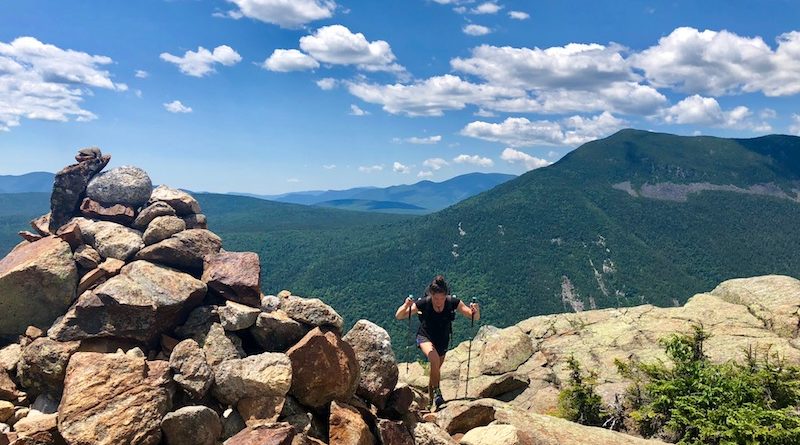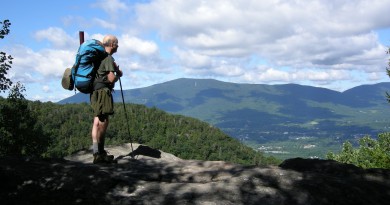Tales from the Triple Crown
Vermont artist Nika Meyers has hiked more than 9,000 miles on the nation’s most daunting trails. Here’s what she’s learned. Plus, the gear that got her there.
“I won’t think about my feet,” Nika Meyers repeated to herself as she climbed the saddle toward the top of 12,000-foot Muir Pass in one of the most remote and rugged stretches of California’s Sierra Nevada. Snow was everywhere underfoot and now it was starting to fall from the sky in big, apocalyptic flakes. She was wearing trail runners.
The patch of frostbite on Meyers’ big toe gnawed at her as she and her twin sister Phebe and their friend tried to find the trail in the accumulating snow. They’d been up since 4:30 a.m. trying to beat the storm that was rolling in. After days of frigid stream crossings and trudging over firm snow to follow the Pacific Crest Trail, they’d finally found the one thing they knew they couldn’t push through: a mid-summer gale on one of the wildest stretches of trail between Mexico and Canada. Their food was limited and, despite the cold and wet and altitude there was only one thing to do: move forward slowly, together.
Their goal? To push from Kearsarge Pass to Mammoth Pass, through the Evolution Valley and up and over the notorious granite crests that draw climbers and skiers to California’s Inyo National Forest.
When the three decided to wait out the storm in their tent, a sense of calm descended. “We had no idea how much it would snow. We were under-prepared. But then I realized, it’s just snow. I’ve grown up in snow. I know snow,” said Meyers, who woke every half hour to knock it off of the tent until morning. “Through that night, cozy in our tent, all I could think of was home and Vermont.”
When the storm lifted and they descended the next day into the Evolution Valley, they met a rare undercast, a layer of low clouds that blanketed the valley.
The Triple Crown
Nika Meyers grew up on a small homestead in Bridgewater, where summers were defined by growing vegetables, springs by sugaring and winters by long days by the woodstove. At 30, she’s hiked more than 9,000 miles. In the summer of 2018, after completing the Appalachian Trail, she became one of just 396 people to have completed the Triple Crown of American long-distance hiking trails.
The American Long Distance Hiking Association administers awards each year to those hikers who complete the three longest National Scenic Trails in America: the 2,600-mile Pacific Crest Trail, the 3,000-mile Continental Divide Trail and the 2,100-mile Appalachian Trail. Together, they traverse the country’s starkest deserts, the highest peak in the Lower 48, desolate highways of the American West and some of the steepest miles of trail in North America, right here in the Northeast.
In total, the trails traverse 22 states, gain 1 million vertical feet and range in elevation from 124 to 14,505 feet above sea level. During her travels, Meyers experienced blizzards and single digit temperatures and sweltering heat that soared into the triple digits.
“Thru hiking changed me,” she says of her travels. “It changed my values and how I relate to people and my surroundings. It reminds me that I am so very small, can control so little and yet can dream so big.”
Along the way, Meyers painted and sketched the landscapes she observed. Today, she’s a finalist in Backpacker Magazine’s “Meet the Artist”
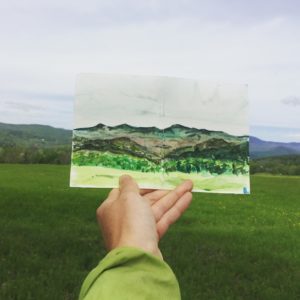
competition for her watercolors, which alternately capture a scene with laser accuracy and imbue it with a sense of magical realism. Geometric shapes emerge from the lines that delineate mountain ranges, canyons and desert mesas. Chaos reigns in other more abstract creations, where light and color and lines seem to celebrate the mess that comes with life on the trail.
“I feel like I am my truest self on the trail, but Vermont will always be my home,” she says. “That landscape and the people and sense of small community that I was raised with are things that still ground me in who I am, no matter where I go.”
Growing Up in Nature
Nika Myers, her twin sister Phebe and their brother Lani, are products of the back-to-the-land movement. Her parents—a master carpenter and a chef—built their own home and decided to homeschool their three children.
As Meyers describes it, their house is one that’s been added to, with angles and nooks and crannies and a big living room and kitchen framed by exposed hemlock beams. “It has this feeling of being nestled into the hillside, and it’s cozy. There are always herbs and peppers drying from the rafters.”
“My mom grows ingredients for the family restaurant, Three Tomatoes in Lebanon, N.H., and the farmers’ market,” says Meyers, who grew up just three miles from the Appalachian Trail. “I didn’t grow up camping, but playing in hills of squash, cabbage, greens and tomatoes and in bean trellis forts.”
At eight, Nika and Phebe co-founded Change the World Kids, now a 501c3 nonprofit that operates in the Woodstock area. Today, the organization organizes local students to do good in the community and improve sustainability in Vermont and abroad.
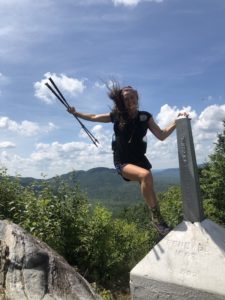
As a kid, Nika’s parents let her creative instincts run wild. “My parents realized I was drawing on the walls when I was in elementary school and in middle school they said, you can draw on the walls if you make a mural,” she recalls. “I think that sense of creativity is what propelled me to study art and keep it up.”
In 2011, after graduating from Mount Holyoke College with a degree in Art and Environmental Studies, Myers took an Americorps position with the Green Mountain Club.
“I was working as the Outreach Specialist, giving trail advice and telling other Vermonters to get out there and explore and I realized that, except for the trails right near my back yard in Bridgewater Corners, I didn’t know much about a lot of it,” says Meyers. “That’s the thing about Vermont: you can grow up being outside here and still find places to explore in this tiny little state.”
In October 2012, she decided to hike the Long Trail—her first ever backpacking trip. “It was wet and cold and the only things I brought with me that I didn’t borrow were my sleeping bag and shoes and underwear.” After covering the 272-mile trail in just 13 days with a 60-plus-pound pack, she was hooked. “Getting to northern Vermont after the hilly farmland and forest of the south was wild. I didn’t know that you could climb ladders and ropes on Mt. Mansfield, or that something so wild existed so close to my home, hidden away. I thought you had to go to New Hampshire for that.”
Meyers was inspired to learn and explore more. “Now, when I go home, I like to just think about that: to know that there is a community moving through the woods of our home state, hidden but still there and part of this vision for the first National Scenic Trail—a trail that was pioneered by so many people who cared for these places before I ever got there. It’s humbling.”
Over the following year, exploring the Green Mountains through building trails and working with Green Mountain Club volunteers and staff was enough. Until she heard about the Pacific Crest Trail.
“It Ruined My Life”
In 2011, as Meyers was starting work at the Green Mountain Club, Jennifer Pharr-Davis completed the 2,185-mile Appalachian Trail in 46 days, 11 hours and 20 minutes. By doing so, she claimed the overall male or female fastest known time on the A.T. Averaging 47 miles per day, she became the first woman to set the mark and has now hiked nearly 14,000 miles of long-distance trails on six continents.
In 2013, Meyers decided to ask Pharr-Davis to speak as part of a series hosted by the GMC. “She and her family actually ended up staying with me,” recalls Meyers, who confided in Pharr-Davis that a friend had asked her to join her for a thru-hike of something called the Pacific Crest Trail, a four-month trip that would necessitate leaving her job at the Green Mountain Club. Meyers was considering joining for a two-week trip instead.
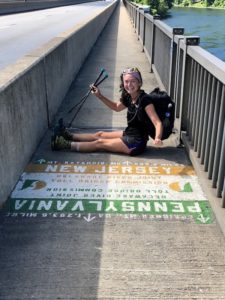
“She told me, ‘I’m going to tell you something I wish someone had told me when I was younger. No one has the time for these things. Hearing the way you’ve talked about your GMC experience and the Long Trail, I think that if this is a big priority for you, you have to make it the priority.’”
Meyers was floored. No other adult had ever suggested she quit her career-track job. “When my commitment was up in November at the GMC, I left to start waiting tables and saving up for the spring. My coworkers and GMC community were actually like, ‘How can we help you? Let’s talk logistics!’ It made me feel like I could do this.”
But her parents weren’t initially supportive. “They’ve always been my biggest cheerleaders and it felt weird to start an adventure that was so big and know that they were not 100 percent on-board,” she says.
On April 9, 2014, she found herself out west for the first time, at the Mexico border with a massive pack stashed full of water for her first day on the PCT. She’d been offered a ride from the airport in San Diego to the trailhead by two elderly trail angels with the trail names Salt and Froto. When a fellow hiker wearing a Stowe 8-Miler t-shirt offered her a wedge of Cabot Cheese at the trail’s start, she felt like she was in the right place.
The deserts of Southern California are raw and hot and barren. Cacti are few and the plants that exist are scraggly and sharp—manzanita, creosote and rabbit brush. The rocks are red and brown and yellow and the hills are relentless and dry. “The first night, I had to hike past my planned campsite because the spring was dry,” said Meyers, who was fresh from mud season in Vermont at the time. “I was so afraid of running out of water that when I found it I carried too much. The second day, I ended up pouring a liter and a half out because I couldn’t bear to carry it on my back in the scorching heat.” That night, there was a frost.
“Nothing looked like what I had envisioned. The plants were different, my feet swelled and I got the most horrifying blisters of my life in shoes I had just bought with hard-earned money, so I kept wearing them.” The terrain challenged her too. “It was this dynamic, water-sculpted landscape that was full of mountains that looked nothing like what I knew, almost like folds of skin.”
Slowly, she learned. She napped from 11 a.m. to 2 p.m. and hiked early in the morning and late into the night. She stopped to clean her feet of dust and rocks at every break. The blisters healed and she ordered a bigger pair of shoes.
When she rolled into Kennedy Meadows, the gateway to the Sierra Nevada and a vital resupply outpost at the end of a 20-plus-mile dirt road in the middle of the longest continuous stretch of wilderness in the lower 48, she didn’t even know what day it was.
“I remember thinking when I saw those big mountains at the same time, that this was the best decision I’d ever made, and that it [had] ruined my life.”
The Mother’s Day surprise
“When I left Vermont, I asked my mom to do one thing for me on this trip,” says Meyers. That thing was to mail her bear canister to the Kennedy Meadows pack station. “I slapped a label on it, was like, ‘Mom, this is in the middle of nowhere and they want your mail weeks before your ETA. I’ll tell you when to send it.”
During strained phone conversations from desert towns, Meyers asked her mother if she had mailed the cannister. Each time her mother’s reply was, “I’ll get to it.”
When Nika arrived at the station, there was no bear can. Her sister was supposed to meet her in just a few days for a particularly remote stretch of trail for which they had just enough food to get them to the next resupply. To make matters worse, there was far more snow than anticipated.
“My mom is normally pretty on top of stuff, so I thought, is she not wanting to support me?” Nika waited with no cell service or internet. When her sister arrived on Sunday morning, she explained that they couldn’t start the trip without the bear can.
“I borrowed this guy’s satellite phone to send an email to my mom along the lines of ‘Hey, where the hell is my bear can?’ Then I was like ‘Oh shit, it’s Mother’s Day!’” She retyped, “Hey mom, happy Mother’s Day you’re the best where the hell is my bear can?” and hit send.
Seconds later, a minivan rolled into the parking lot and Phebe tried to stifle a grin. “It’s like a 25 percent grade on a dirt mountain pass to get up there, so there weren’t a whole lot of rental minivans around,” said Meyers. Her mom rolled down the window and said, “Hey Nika!”
When she saw her brother and dad step out of the car, she ran over chairs and through a sea of lounging, ripe thru-hikers to give her mom a hug. They promptly fed just about every hiker around and ate a massive meal of homemade food before seeing Nika and Phebe off.
“It was like a weight had been lifted that was preventing me from enjoying the experience. This trail brought my family together in a really cool way I could never have anticipated.”
She went on to hike the most strenuous sections of the trail knowing she had her family’s support, stacking up big mile days and pushing through hundreds of miles of snow travel in the jagged and hostile high Sierra.
By the time she finished on August 9, 122 days after she started, Meyers was hardened and fit, a seasoned hiker who had earned a reputation for jumping fiercely into each day on the trail and painting plants, animals, tracks and landscapes along the way. She discovered, with joy, that she could hike for 50 miles at a time and still find room to dance and sing and sketch as she went.
“It was in those early mornings, on big days, where I found what I think of as the truest version of myself and became who I am now: Early Bird.” That became her trail name.
Life on the Trail
When she returned home to Vermont in the summer of 2014, Meyers struggled to adjust to living life in one place. She spent a summer working on the Green Mountain Club’s trail crew. “I fell in love with the work and the place again, but I felt like I’d tapped into this animal on the trail that I’d never before experienced. Being in Vermont was really hard and weird for the first time ever,” says Meyers.
Another job took her to the Cascades in Washington, but she kept yo-yoing back to Vermont. Then in May 2016, she set out to hike the Continental Divide Trail, which runs from Mexico to Canada through New Mexico, Wyoming, Idaho and Montana. Rugged and diverse, with a mix of Rocky Mountain plateaus, harsh deserts and the remote roads of the Great Plains, it was an exercise in navigating. The 3,000-mile trail was formally established in 2012 and as of 2018, only about 150 people had hiked the length of the trail, which is still “incomplete.”
“This was a mental challenge, a massive exercise in ‘choose your own adventure,’” says Meyers, who struggled not to
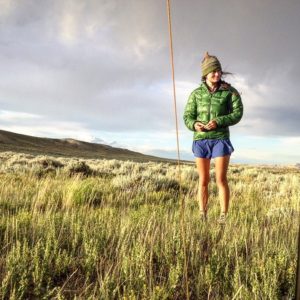
compare the trail with her euphoric experience on the PCT. The extensive navigation required to connect sections of the trail made it hard to find a sense of rhythm. “The weather was crazy through the Rockies. I fell in love with small town libraries and laundromats, places I was forced to take shelter during violent thunder storms.”
There was also a lot of road walking. “Starting in New Mexico, I felt like I couldn’t believe that some of the communities were even part of the United States. I understood how they could feel forgotten [by national politics].” In Wyoming, she encountered an Obama effigy hanging above the bar in a saloon. She couldn’t help but feel far from Bridgewater.
It was also the 2016 election season, and she was hiking with a companion who was gay. Hitch-hiking, she often felt uncomfortable when drivers went out of their way to express deeply socially and politically conservative beliefs, especially when they included homophobic views. Meyers and her hiking partner talked little during one experience that turned especially toxic, even pretending to be a heterosexual couple when a driver went on a homophobic rant.
On another occasion, Meyers was open about her more liberal political views with a woman who had offered them a 13-mile ride back to the trail and espoused her own conservative political leanings. “I decided to have a candid conversation,” said Meyers. They bantered and listened to each other and parted amicably.
Meyers finished the trail in Glacier National Park on Sept. 11, with the feeling that she’d just met her country for the first time.
“I’ve always felt very safe on trails as a cis female,” she says. “They’re the places where I get to feel most comfortable in my body. Now I have a clearer view of how that could be different for someone else. Everyone deserves to be able to be safe in expressing who they truly are on the trail. As members of outdoor communities, we need to work on that.”
I’m Here Because of You
When Meyers returned to Vermont, it was to the sad news that her first boss and mentor at the Green Mountain Club, Dave Hardy, had been diagnosed with cancer. She dove back into the Green Mountain Club Community as a volunteer, while working at her parents’ restaurant.
“It was a fun year. I reacquainted myself with my communities—the people who raised me with my parents in Bridgewater Corners, at the restaurant. I walked every dirt road in my town,” she recalls.

Then, in April 2018, she hit the trail again. This time, she tackled the Appalachian Trail. From Georgia to Harpers Ferry, West Virginia, she rose early to find solitude, passing most other hikers while they were still in their tents.
At Trail Days, the epic annual reunion and trail festival at the halfway mark in Damascus, Va. in late May, she saw Jennifer Pharr-Davis and told her she was going for her Triple Crown. “I’m here because of you,” said Meyers. Pharr-Davis gave her a big hug.
Along the A.T., she met a hiker who went by the trail name “Koolaid.” Koolaid matched her quick pace and 40-mile days and they fell in love in the rain and mud of the Shenandoah’s. He left the trail briefly and she carried on, solo. Later, she met a crew of trail volunteers in the Blue Ridge Mountains who knew Dave Hardy and invited her to an on-trail feast on a rainy night at a cabin reserved for club members. In Connecticut, her 92-year-old grandmother, who had hiked in the White Mountains of New Hampshire in her youth, met her for a short section of trail outside of Kent. She told Nika she’d trained for weeks at the local gym to make the trip. “The Appalachian Trail was a green tunnel of tight little communities. I kept meeting people who knew people from all parts of my life,” said Meyers.
When she finished the trail on July 16, 2018 on the summit of Katahdin, it was with Koolaid and her dad on a misty day. “Having the Triple Crown and sharing that experience with my dad, after all that time since I’d first quit my job to pursue this dream was pretty special.”
Always Another Trail
Meyers has since hiked the 800-mile Arizona Trail and has her sights set on the 486-mile Colorado Trail. She and Koolaid have stayed together, pushing each other to take on bigger days and new skills.
“I’ve refocused on my art,” says Meyers. “When I was in college, I was preoccupied with changing landscapes and the environment. I’d hodgepodge these detailed nature drawings together. Traditional landscape painting didn’t feel true to the layered and fractured landscapes I saw.”
While working trail crew in Vermont, she started making linoleum prints. “We were creating miles of brand-new trail for a reroute up Bolton Mountain from Winooski. We were cutting trees down, ripping roots out and scraping away dirt,” recalls Meyers. “Benching a trail, it’s almost as if you have a piece of linoleum and are carving into a block. Printmaking involves repetitive motion, peeling back and applying various layers to a piece. It was a relaxing way to translate the experience I was having on-trail.”

On the CDT, she toted precut watercolor paper squares—meticulously folded accordion-style—and painted nearly every day through New Mexico. “It’s a strange timeline of my journey, with the end disjointed. But then, so are memories of a trail. They fold together in a similar fashion in your mind.”
These days, she loves geometric shapes and lines. “I’ve worn one pair of shoes—Brooks Cascadias—for each of my thru hikes, so I know what the treads look like in different substrates. I like to weave them into watercolors of landscapes that feature lots of elevation profiles like a map. The paintings let me remember the features of the places and the lines remind me of where I was going at the time.”
Today, her sights are set on the 812-mile Hayduke Trail and on international travel. “I’d love to experiment with piecing together routes that are incomplete,” she says. Meyers coaches Nordic skiing in the winter, leads hikes as a science teacher in Aspen, Colo. in the summer, paints and continually circles back to Vermont. She thinks she’ll someday wind up like her parents: an artist living and creating quietly in the cozy shadow of the Green Mountains.
“I suspect that someday, home will call me back. But for now, there is always another trail.”
 When she finished the Appalachian Trail and her Triple Crown on the summit of Katahdin (5,269 feet) in Maine in July 2018, Meyers was met by her dad, toting a crown made for her by her nephew. Photo by Robert Meyers
When she finished the Appalachian Trail and her Triple Crown on the summit of Katahdin (5,269 feet) in Maine in July 2018, Meyers was met by her dad, toting a crown made for her by her nephew. Photo by Robert MeyersFeatured Photo Caption: Nika Meyers hikes through New Hampshire on her way to completing the Triple Crown. Photo courtesy Nika Meyers

